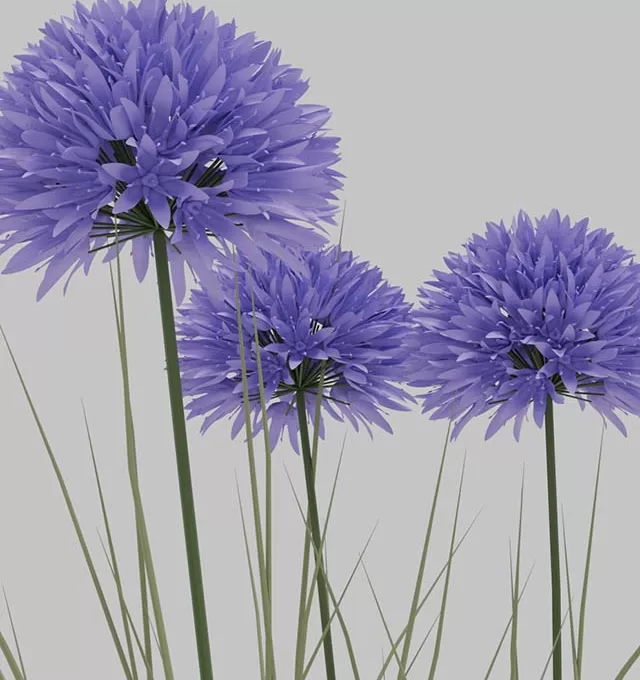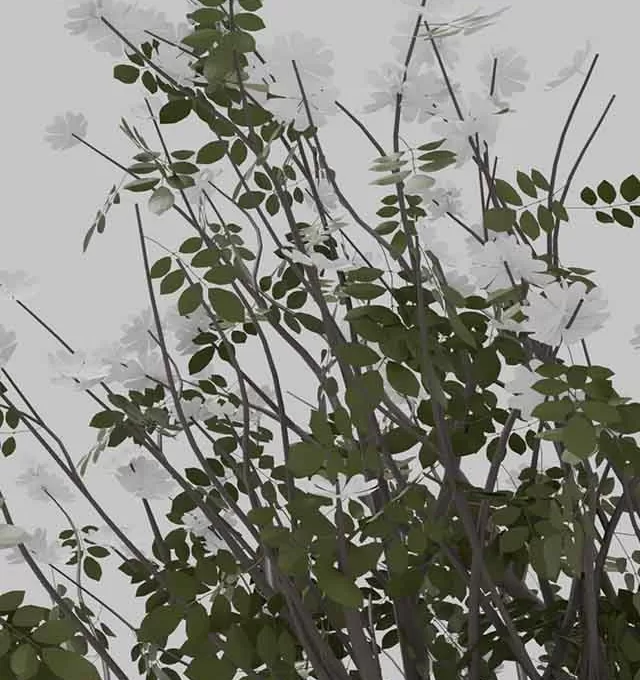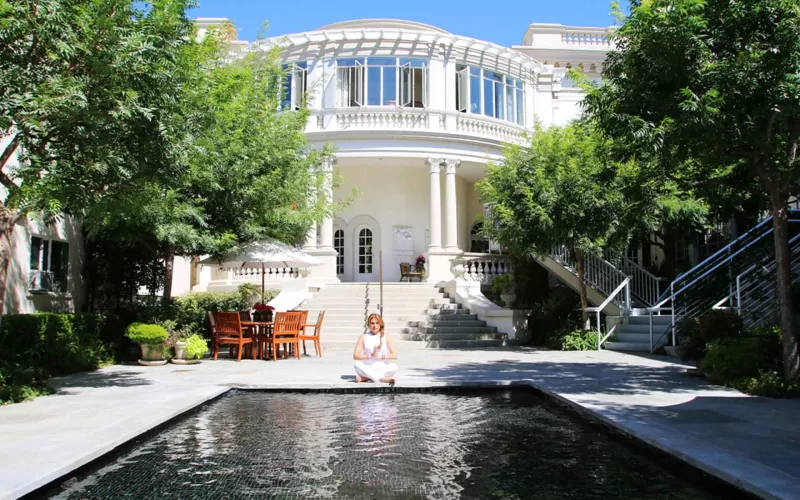A designer, researcher, and educator based in Boston, Massachusetts, Sonia Sobrino Ralston is a Research and Teaching Fellow in Art and Design at the Northeastern University College of Art, Media and Design, and a Lecturer at the University of Pennsylvania.
However, her journey first began from a point of uncertainty. After earning a Master’s degree in Architecture at Princeton University, Ralston felt that she lacked the artistic and design language to delve into her interest in ecology, and sought to go beyond the confines of traditional architecture. She then earned a Master’s degree in Landscape Architecture at Harvard University, where she started to think about plants as sensors and repositories for information. This culminated in a thesis project, Uncommon Knowledge: Practices and Protocols for Environmental Information, which presented a speculative, decentralized data center following the rhythms of environmental cycles, with plants as sensors.
The environment is its own complicated set of assemblages that are changing and responding in real time
The seeds planted by this thesis project are evident in Plants: Informational Entities Over Time. This piece uses the data of a white oak tree, believed to be over 200 years old, affectionately referred to as ‘Granny Oak’, which fell in 2017 in Pelham Bay Park. The multi-screen installation uses data from Entitation Map NYC and Tropobathymetric LIDAR NYC data from 2007 and 2017 to demonstrate the potential of plants as informational markers of time. The center screen of the project uses high-fidelity botanical models to depict the site where Granny Oak stood in the 2007 Entitation map site survey. The left screen displays a reconstruction of the plant community using animations and LIDAR data from the site in 2007, while the right screen reconstructs the plant community at the memorialized site of Granny Oak using data collected by Ralston in 2024, now covered by a thick layer of invasive rose bush.
Plants: Informational Entities Over Time by Sonia Sobrino Ralston was presented at the 2024 Data Through Design Exhibition in New York City, an annual art exhibition part of New York City’s Open Data Week, which features works that analyze, interpret, and interrogate data sourced through the NYC Open Data Portal. This interview explores Ralston’s process and intentions in developing this project, a visually striking installation that represents plants as living sensors to consider the aftermath of ecological change.
Your DxD artist bio says your work “explores how plants and information systems collide with the environment”. What does this mean? What influences led you to this interest?
Sonia Sobrino Ralston – Part of my work now is exploring the digital asset within the design space and how you can use a digital plant asset in a world-building operation where you ultimately are using these plants to envision the future. When people make renders in architecture and landscape, for example, you have a big library of plants that you just plug in. I was interested in asking, why is that the standard asset? Why don’t we spend the time to develop and think about our different assets?
The kind of information systems that I’m colliding within this ‘new to me’ area of design research that I’m working on is this question of “How are the plant assets that we use affecting our visions of the future and what is the politics behind what assets are available?” So I’ve been modeling these plants. I’m not an animator, I’m not a game designer, I’m not an expert on any of these things. It’s all self-taught tools because I was searching for a way to represent the plants I was researching through different kinds of site research while also trying to think about how these appear in digital space.
In terms of historical work, some amazing architectural and landscape historians have been talking a bit about the circulation of different kinds of representations of plants. In particular, Zeynep Çelik Alexander is a Professor at Columbia University whose work focuses on Architectural History. She wrote a paper that was influential to me because it talked about the ways that herbaria – places where dead plant images are stored – were tools of colonial operations, and that these plant representations, the papers themselves, were more important in terms of their economics and circulation as a means to control the empire than they were important as valuable, representations of the plant. In this paper, she also compared it a bit to the kind of digital clearing houses that we have now in the form of data centers where the object of the information carries monetary value and is the thing we care about rather than the representation of it.
That became important to me in thinking about how all these different kinds of colonial forces are embedded into these systems in ways that we understand plants, just from this Western mindset where plants were used as a tool of value or commerce.
The DxD Exhibition features projects that source data from the NYC Open Data Portal. How did you choose the data set you worked with?
Sonia Sobrino Ralston – I found this Entitation study and I had so many questions about it. It was just so weird. ‘Entitation’ sounds like a made-up word. It is a method of species surveying that is specifically used in urban sites because there is so much disturbance from human activity and things like pollution, cars…. So they developed this method that was tested in 1986 in Pelham Bay Park. They used an aerial survey to designate a bubble map of diagrams of where different species, or say, ‘entities’ are. Then they went to go ground-truth it.
When I was reading about this study, I didn’t fully understand what was going on for a while. But then I got into it and I looked at the catalog, it’s just an amazing list. An incredible record of hand labor. Then, they sent people in the field: so ecologists, volunteers, and also probably summer interns, to go out and check what species were living in these areas in 1986, at the time of the survey.
It was so interesting to me. It’s like hundreds of page-long documents – a record of what was there in 1986, until I found out that was the last research on that area that was done. That’s how I ended up on this topic, which was basically completely by accident and I just kept asking questions.
The theme of this year’s DxD Exhibition was Aftermath. How did you interpret this theme through your project?
Sonia Sobrino Ralston – I went to visit the site [of Granny Oak] and I quickly realized there was a devastating aftermath that had happened there. For years, the different community groups and parks boards have been fighting against a highly invasive rose species called multiflora rosa. When I went to the site, it was early January, but the leaves [of the rose] were already starting to bud. The entire site, which had previously been this huge tree providing lots of shade for all these different species that were shade-tolerant to live there, had been completely overrun by at least 10 feet deep of rosebush. When they’re already sprouting, it means they’re proactive, because they want to get all the light. Then they consume all the light in the woodlands and all the species that live on the ground level of the woodlands get outcompeted for light immediately. It was crazy to see the intensity of the invasive species taking over just because of this gaping hole in the canopy from the oak tree dying.
The way I was thinking about Aftermath was just the aftermath of this particular event– of the oak tree dying – but also, on top of that, the aftermath of different kinds of labor that had been happening in the park in terms of taking stock of what was there, but then also the labor of people – volunteer labor for the most part – in trying to keep invasive species at bay, or trying to preserve as much as they could of this ecological system that is more or less only available in this particular part of New York City.
Is there anything new that you learned while working on this project?
Sonia Sobrino Ralston – In terms of things that were new… it was trying to think about telling this data story without designing an ‘interior-vention’. In my experience as a landscape designer and an architectural designer, you often use data to take stock of the site and then imagine a future coming from it. This is something that I think has a lot of problems because it results in a lot of positivism in the design disciplines. It was interesting as a way of working to just ask, ‘How do I tell the story of this data without proposing an intervention?’
So it was liberating in some ways to just be like, “I’m just going to tell a story about this data and this tree and try to learn as much as I can about the tree”, which was a really exciting way to work.
You mentioned going beyond intervention with this project. What would you want viewers and people interacting with this work to take away from it?
Sonia Sobrino Ralston – I would want people to spend more time and attention on the different kinds of plant life that happen around them in urban settings. Some people do this very well, but it’s not something that I, before getting into landscape architecture, really thought that much about. I would hope people understand that the environment is its own highly intelligent system. The environment is its own complicated set of assemblages that are changing and responding in real time.
The environmental record is reflected within trees. They move at a very, very slow period. When you start to appreciate the slowness of everything changing, and not expect the responses to be immediate in understanding them, I think that’s really important.
And then on top of that, would be the labor that goes into maintaining a place, not only in terms of the labor that went into making this dataset but also the labor of landscape workers having to come out and remove an invasive rose species. A lot of work is involved to commune and live in a nice environment. There is so much maintenance that has to happen.
I would hope people understand that the environment is its own highly intelligent system.
Do you have any upcoming projects or ideas for future projects that you would like to pursue?
Sonia Sobrino Ralston – I am doing a project in collaboration with the Arnold Arboretum of Harvard University. There, they have a bunch of deaccession records. It’s kind of an euphemism, but it means there are dead trees there. Eventually, at some point, in the collections, trees die, and they get cut down. There, they do turn some of the trees into benches, which is nice, and they’ll have a tag about where the wood came from, but it makes people sad to see a stump in a tree collection. So what I’m going to be doing there is an AR Exhibition called Ghost Trees, and there will be a few trees on the side of the Arboretum which I’ll digitally recreate based on photos and other materials that I can get my hands on, like herbaria materials that they have there. You can visit as a digital simulacrum.
One of the trees is a cork tree. It famously fell in 1995. It was the only tree you were allowed to climb in the Arboretum because they couldn’t stop people from climbing on it. It had these nice, low branches that you could sit on. And so, little schoolchildren, students, would come and sit on it. Eventually, I think when kids were sitting on it, it fell, so that’s one of the trees I’m going to recreate. No one was harmed! But I’m going to make it so that you can visit that cork tree.












